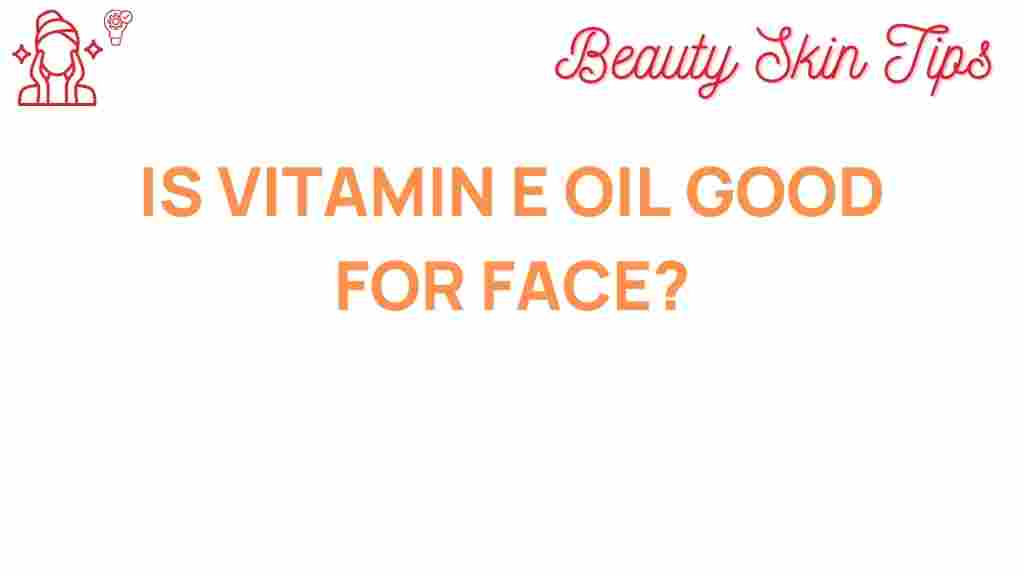Unveiling the Truth: Is Vitamin E Oil Good for Your Face?
Vitamin E oil has gained significant attention in the beauty industry due to its purported benefits for the skin, particularly for the face. As a powerful antioxidant, it is often hailed for its ability to nourish and protect the skin. But is Vitamin E oil really good for your face? In this article, we will explore the benefits, application methods, potential drawbacks, and more, to help you make an informed decision about incorporating this oil into your skincare routine.
What is Vitamin E Oil?
Vitamin E oil is a fat-soluble vitamin that exists in several forms, with alpha-tocopherol being the most common in supplements and skincare products. This oil is known for its antioxidant properties, which help combat oxidative stress in the skin caused by environmental pollutants and UV rays. It is often derived from natural sources, including nuts, seeds, and green leafy vegetables.
Benefits of Vitamin E Oil for Your Face
Using Vitamin E oil on your face can offer a myriad of benefits, including:
- Moisturization: Vitamin E oil is an effective moisturizer that helps to hydrate the skin, making it ideal for those with dry or flaky skin.
- Anti-Aging Properties: The antioxidant properties of Vitamin E help reduce the appearance of fine lines and wrinkles, promoting a more youthful complexion.
- Scar Healing: Some studies suggest that Vitamin E oil can assist in the healing of scars and improve skin texture.
- Sun Protection: While it shouldn’t replace sunscreen, Vitamin E can provide an extra layer of protection against UV damage.
- Skin Repair: Vitamin E oil can help soothe and repair damaged skin, making it beneficial for conditions like eczema or psoriasis.
How to Use Vitamin E Oil on Your Face
Incorporating Vitamin E oil into your skincare routine can be done in several ways. Here’s a step-by-step guide:
Step 1: Choose the Right Product
Look for pure Vitamin E oil or products that list Vitamin E as one of the main ingredients. Ensure it is suitable for facial application. You can find Vitamin E oil at health stores, online, or in some pharmacies.
Step 2: Patch Test
Before applying Vitamin E oil to your face, conduct a patch test on a small area of skin to check for any adverse reactions. Apply a small amount and wait 24 hours. If no irritation occurs, you can proceed.
Step 3: Cleanse Your Face
Start with a clean face. Use your favorite cleanser to wash away any dirt, oil, or makeup. Pat your skin dry with a clean towel.
Step 4: Application
You can apply Vitamin E oil in different ways:
- Direct Application: Take a few drops of Vitamin E oil and gently massage it onto your face using your fingertips. Focus on areas that need extra moisture or care.
- Mix with Moisturizer: Add a few drops of Vitamin E oil to your regular moisturizer for an added boost of hydration.
- As a Night Treatment: Apply Vitamin E oil before bed to allow it to work overnight, enhancing skin repair and hydration.
Step 5: Allow Absorption
Give your skin time to absorb the oil. You may want to wait a few minutes before applying makeup or other products.
Precautions When Using Vitamin E Oil
While Vitamin E oil can be beneficial, there are some precautions to consider:
- Comedogenic Potential: Vitamin E oil can be comedogenic for some skin types, meaning it may clog pores and cause breakouts. If you have oily or acne-prone skin, consider using it sparingly or avoiding it altogether.
- Allergic Reactions: Some individuals may experience allergic reactions to Vitamin E oil. Always perform a patch test before full application.
- Quality Matters: Ensure you are using high-quality Vitamin E oil, as lower-quality products may contain additives or preservatives that could irritate your skin.
Troubleshooting Common Issues
If you experience any issues while using Vitamin E oil, here are some troubleshooting tips:
Issue: Breakouts
If you notice increased breakouts after using Vitamin E oil, consider:
- Reducing the frequency of application.
- Switching to a lighter formulation or oil if you have oily skin.
- Consulting a dermatologist for alternative options.
Issue: Greasy Residue
If Vitamin E oil feels too greasy on your skin, try:
- Mixing it with a lighter moisturizer.
- Using it only at night.
- Applying it in smaller amounts.
Complementing Vitamin E Oil in Your Skincare Routine
To maximize the effectiveness of Vitamin E oil, consider incorporating other complementary ingredients:
- Vitamin C: Using Vitamin C in the morning and Vitamin E oil at night can enhance skin protection and repair.
- Hyaluronic Acid: This ingredient can help lock in moisture when used in conjunction with Vitamin E oil.
- Retinol: Retinol can help with anti-aging, and when combined with Vitamin E oil, it can reduce irritation often associated with retinoids.
For more detailed information on skincare ingredients, check out this comprehensive guide.
Conclusion
In summary, Vitamin E oil can be a beneficial addition to your skincare routine if used correctly. Its moisturizing, healing, and anti-aging properties make it a popular choice among skincare enthusiasts. However, it is essential to consider your skin type and any possible reactions before incorporating it. Always perform patch tests, use high-quality products, and consult with a dermatologist if you have concerns. With proper application and care, Vitamin E oil can help you achieve a healthier, more radiant complexion.
For those looking to explore more about skincare ingredients and their benefits, be sure to read more on our skincare blog.
This article is in the category Skincare and created by BeautySkinTips Team
